| |||||
| Decades: | |||||
|---|---|---|---|---|---|
| See also: | Other events of 1689 History of France • Timeline • Years | ||||
Events from the year 1689 in France .
| |||||
| Decades: | |||||
|---|---|---|---|---|---|
| See also: | Other events of 1689 History of France • Timeline • Years | ||||
Events from the year 1689 in France .
The 1690s decade ran from January 1, 1690, to December 31, 1699.

The 1680s decade ran from January 1, 1680, to December 31, 1689.

1755 (MDCCLV) was a common year starting on Wednesday of the Gregorian calendar and a common year starting on Sunday of the Julian calendar, the 1755th year of the Common Era (CE) and Anno Domini (AD) designations, the 755th year of the 2nd millennium, the 55th year of the 18th century, and the 6th year of the 1750s decade. As of the start of 1755, the Gregorian calendar was 11 days ahead of the Julian calendar, which remained in localized use until 1923.
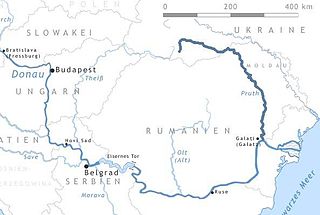
1711 (MDCCXI) was a common year starting on Thursday of the Gregorian calendar and a common year starting on Monday of the Julian calendar, the 1711th year of the Common Era (CE) and Anno Domini (AD) designations, the 711th year of the 2nd millennium, the 11th year of the 18th century, and the 2nd year of the 1710s decade. As of the start of 1711, the Gregorian calendar was 11 days ahead of the Julian calendar, which remained in localized use until 1923.

1689 (MDCLXXXIX) was a common year starting on Saturday of the Gregorian calendar and a common year starting on Tuesday of the Julian calendar, the 1689th year of the Common Era (CE) and Anno Domini (AD) designations, the 689th year of the 2nd millennium, the 89th year of the 17th century, and the 10th and last year of the 1680s decade. As of the start of 1689, the Gregorian calendar was 10 days ahead of the Julian calendar, which remained in localized use until 1923.
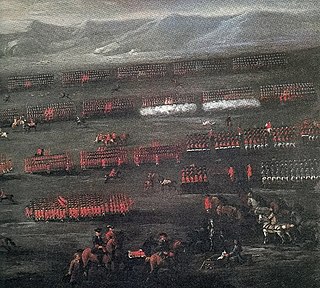
1715 (MDCCXV) was a common year starting on Tuesday of the Gregorian calendar and a common year starting on Saturday of the Julian calendar, the 1715th year of the Common Era (CE) and Anno Domini (AD) designations, the 715th year of the 2nd millennium, the 15th year of the 18th century, and the 6th year of the 1710s decade. As of the start of 1715, the Gregorian calendar was 11 days ahead of the Julian calendar, which remained in localized use until 1923.

1701 (MDCCI) was a common year starting on Saturday of the Gregorian calendar and a common year starting on Wednesday of the Julian calendar, the 1701st year of the Common Era (CE) and Anno Domini (AD) designations, the 701st year of the 2nd millennium, the 1st year of the 18th century, and the 2nd year of the 1700s decade. As of the start of 1701, the Gregorian calendar was 11 days ahead of the Julian calendar, which remained in localized use until 1923.

1696 (MDCXCVI) was a leap year starting on Sunday of the Gregorian calendar and a leap year starting on Wednesday of the Julian calendar, the 1696th year of the Common Era (CE) and Anno Domini (AD) designations, the 696th year of the 2nd millennium, the 96th year of the 17th century, and the 7th year of the 1690s decade. As of the start of 1696, the Gregorian calendar was 10 days ahead of the Julian calendar, which remained in localized use until 1923.

1693 (MDCXCIII) was a common year starting on Thursday of the Gregorian calendar and a common year starting on Sunday of the Julian calendar, the 1693rd year of the Common Era (CE) and Anno Domini (AD) designations, the 693rd year of the 2nd millennium, the 93rd year of the 17th century, and the 4th year of the 1690s decade. As of the start of 1693, the Gregorian calendar was 10 days ahead of the Julian calendar, which remained in localized use until 1923.

1686 (MDCLXXXVI) was a common year starting on Tuesday of the Gregorian calendar and a common year starting on Friday of the Julian calendar, the 1686th year of the Common Era (CE) and Anno Domini (AD) designations, the 686th year of the 2nd millennium, the 86th year of the 17th century, and the 7th year of the 1680s decade. As of the start of 1686, the Gregorian calendar was 10 days ahead of the Julian calendar, which remained in localized use until 1923.

The Acadians are the descendants of the French who settled in Acadia during the 17th and 18th centuries.

The Peace of Ryswick, or Rijswijk, was a series of treaties signed in the Dutch city of Rijswijk between 20 September and 30 October 1697. They ended the 1688 to 1697 Nine Years' War between France and the Grand Alliance, which included England, Spain, Austria, and the Dutch Republic.

The Nine Years' War (1688–1697), often called the War of the Grand Alliance or the War of the League of Augsburg, was a conflict between France and a European coalition which mainly included the Holy Roman Empire, the Dutch Republic, England, Spain, Savoy and Portugal. It was fought in Europe and the surrounding seas, in North America, and in India. It is sometimes considered the first global war. The conflict encompassed the Williamite war in Ireland and Jacobite risings in Scotland, where William III and James II struggled for control of England and Ireland, and a campaign in colonial North America between French and English settlers and their respective Native American allies.
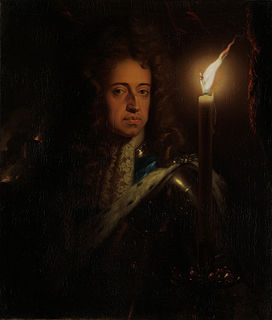
The Grand Alliance was the anti-French coalition formed on 20 December 1689 between England, the Dutch Republic and the Holy Roman Empire. It was signed by the two leading opponents of France: William III, King of England and Stadtholder of the Dutch Republic, and Emperor Leopold, on behalf of the Archduchy of Austria.
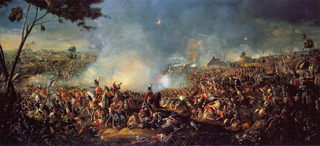
The Second Hundred Years' War is a periodization or historical era term used by some historians to describe the series of military conflicts between Great Britain and France that occurred from about 1689 to 1815. The Second Hundred Years' War is named after the Hundred Years' War, when the rivalry between England and France began in the 14th century. The term appears to have been coined by J. R. Seeley in his influential work The Expansion of England (1883).
Events from the year 1692 in France.
Events from the year 1695 in France.
Events from the year 1697 in France
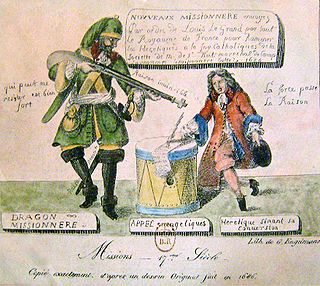
Events from the year 1681 in France

Events from the year 1678 in France